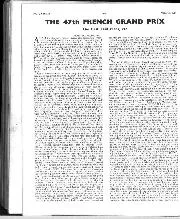Following the death of Alberto Ascari, in 1955, no Italian driver had emerged at the very top level. True enough, Eugenio Castellotti and Luigi Musso had raced with some distinction, but the philosophy at Maranello in those days was to sign more drivers than needed, so that they were always competing with each other for a drive in the next race. Castellotti and Musso, braver than was good for them, were both killed in Ferraris.
It was Musso’s death, at Reims in 1958, which led Count Johnny Lurani to come up with the idea of Formula Junior, in the hope of creating a breeding ground for world-class Italian drivers. Baghetti decided this was for him, and in 1960 won the Italian title with a front-engined Dagrada-Lancia.
Not unnaturally, he harboured dreams of one day driving for Ferrari, but in fact Enzo’s inclination was increasingly to look outside Italy. Within 18 months, he had lost not only Castellotti and Musso, but also Alfonso de Portago and Peter Collins, and he had been roundly denounced by large sections of the press.
“‘The Old Man was getting criticised to hell,” remembers Phil Hill, “and of course the Vatican pitched in, saying racing should be banned, and Ferrari was a killer of young men, and all that stuff The Vatican always pitched in…”

Baghetti (far left) with Lorenzo Bandini, Phil Hill, Jo Siffert and Richie Ginther
Grand Prix Photo
That being so, Ferrari was not predisposed to sign any more Italians, for when the country’s own sons were involved in tragedy, the condemnation of him was always especially vociferous. But as so often with this unpredictable man, it put him into conflict with himself; for in his heart what he wanted most was to see Italian drivers winning for Ferrari.
What followed was a classic Maranello fudge. For 1961 the factory F1 drivers were Hill, von Trips and Ginther, but it was suggested to Eugenio Dragoni (later a highly controversial Ferrari team manager, but then operating the small Scuderia Sant Ambroseus) that perhaps he might care occasionally to run a fourth car for a promising Italian.
Thus Enzo was able to keep faith with his patriotic stirrings, but was also — since it would not be a factory-entered car— distanced from potential censure, should anything go awry.
Initially, Lorenzo Bandini, another star of FJunior, was favoured for the drive, but in the end a scarcely believing Baghetti was chosen. This was the first year of the new 1.5-litre F1, for which Ferrari was very well prepared, and the British teams emphatically not. Lotus, Cooper and the rest had early notice of the form the season would take: at Syracuse, there were no works Ferraris on the entry list, but the ‘private’ car was down to run, driven by one G Baghetti.





